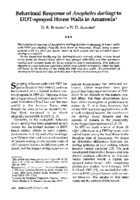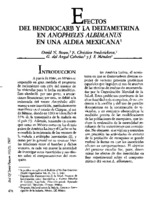Behavioral response of Anopheles darlingi to DDT-sprayed house walls in Amazonia
| dc.contributor.author | Roberts, Donald R | es_ES |
| dc.contributor.author | Alecrim, W.D | es_ES |
| dc.date.accessioned | 2016 | |
| dc.date.available | 2016 | |
| dc.date.issued | 1991 | es_ES |
| dc.identifier.uri | https://iris.paho.org/handle/10665.2/27085 | |
| dc.description.abstract | The behavioral response of Anopheles darlingi females to spraying of house walls with DDT was studied along the Ituxi River in Amazonas, Brazil, using a house sprayed with 2 g DDT per square meter of wall surface and an untreated house serving as a control. It was found that hardly any An. darlingi females entered , exited, or took blood meals inside the treated house after it was sprayed with DDT, and that specimens marked and released inside the house tended to depart immediately. This behavior appears to constitute true repellency rather than contact irritability. Since the typical house in the vicinity of the study site had only two walls, the persistence of malaria in the local area was probably due to home construccion practices | en_US |
| dc.description.abstract | Published in Spanish in Bol. Oficina Sanit. Panam 110(6):480-88, 1991 | es_ES |
| dc.format.extent | graf | es_ES |
| dc.relation.ispartofseries | Bulletin of the Pan American Health Organization (PAHO);25(3),1991 | en_US |
| dc.subject | Malaria | es_ES |
| dc.subject | Mosquito Control | es_ES |
| dc.subject | Anopheles | es_ES |
| dc.subject | Fumigation | es_ES |
| dc.subject | DDT | es_ES |
| dc.subject | Brazil | en_US |
| dc.title | Behavioral response of Anopheles darlingi to DDT-sprayed house walls in Amazonia | es_ES |
| dc.type | Journal articles | en_US |
| dc.rights.holder | Pan American Health Organization | en_US |
Arquivos deste item
Este item aparece na(s) seguinte(s) coleção(s)
-
Pan American Journal of Public Health
Revista Panamericana de Salud Pública




